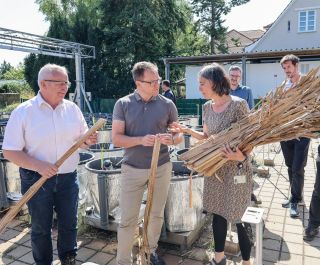Environmental minister Schneider at GMC
by Helena Plochberger (comments: 0)
At inaugural visit to MV

04/07/2025 On 3rd of July 2025, Federal Minister Carsten Schneider of the German Federal Ministry for the Environment, Climate Protection, Nature Conservation and Nuclear Safety (BMUKN) had a stopover at the Greifswald Mire Centre during his first official inaugural trip through Mecklenburg-Western Pomerania. The message was clear: peatlands must remain at the top of the agenda in today's environmental policy.
Franziska Tanneberger, winner of the German Environmental Award 2024, and colleagues demonstrated at various places in and around Greifswald how science on peatlands can be used as a basis for political decisions and how business models can be developed from sustainable peatland use and be scaled up. At the Karrendorf meadows, Schneider could observe field research of the DFG-funded WETSCAPES project of the University of Greifswald on the ground and also the peatland protection of the Succow Foundation, which owns the nature conservation areas there.
At Greifswald itself, the GMC peatland experts took the VIP-visitor to the mesocosm facility, which monitors plant growth in 108 mini bogs, to the clone collection with 200 reed and 500 peat moss clones, as well as to the peatland library with more than 50,000 publications. They showed the database on peatlands worldwide and at the Michael Succow Foundation first paludiculture products from an an alliance of several companies. This all made clear:
The Greifswald Mire Centre‘s work has not only raised public awareness over the last 10 years, but has also attracted the interest of large business groups. Germany thus has the opportunity to expand its pioneering role in climate protection through rewetting and paludiculture. Environmental Minister Schneider was impressed: "The University of Greifswald’s peatland research is a unique selling point! MV Environment and Agriculture Minister Dr Till Backhaus also supports the long-term preservation and expansion of this in a non-university research institution.











